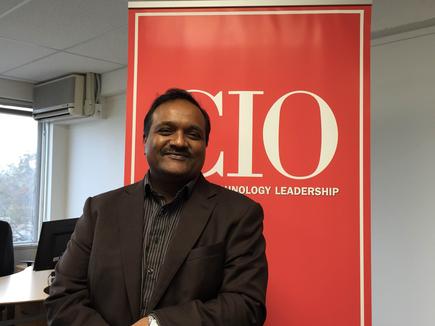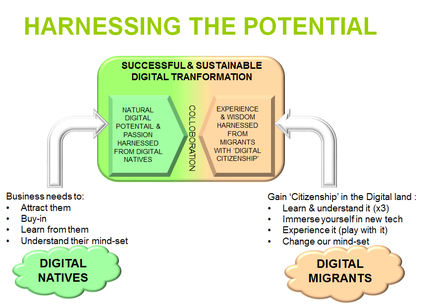
This is part one of a two-part article on digital transformation. Read part two here.
Richard Raj says enterprises had different responses when discussions emerged on the need to become digital businesses.
Some companies “waited it out”, recalling the dotcom era and its spotty record of winners and losers, he says. Or they thought, “Yes, we have a few internet projects, we are okay.”
Other companies, however, delved into it and invested in major digital projects.
Then startups disrupted traditional industries. Out of the blue, those industries that did not invest in digital areas started to get disrupted too, he says.
“When I think of taxi companies, they thought, 'everybody needs transport'. They continued to optimise the systems for the drivers and the head office.
“After Uber took off, some taxi companies were talking about starting an Uber equivalent. By that time, Uber already had got the market share.
“It is not that you will never get disrupted, nothing is safe,” says Raj, who is Group Digital Solutions and Innovations manager for Business Technology at Frucor Beverages.

You have to really immerse yourself in the digital technology, understand what are the key dynamics around it. What is ahead of us? What is being innovated now?
Digital migrants and digital citizens
Raj says the disruption wrought by digital startups to traditional businesses is happening in a similar way to the heads of ICTs and IT teams today.
Most people in the senior ICT management layer today rose through the ranks.
“We know our job around technology really well,” he says, referring to the current executives holding the titles of CIO, CTO, CDO.
“We have been adding value to the business for some time,” says Raj, who has held managerial roles since the early 90s.
In his case, his roles ranged from applications/operations manager, through to development manager, manager IT services and solutions, head of business solutions to acting group IT director, working in publishing, manufacturing, media, entertainment and transportation and warehousing operations.
“However, in my experience in the digital space, it's a whole new ball game. A lot of the way we used to do things before, and the way we matured, is no longer very relevant in terms of how we approach processes and even the technology in the digital space.''
For a CIO who is tasked to also take on the role of the chief digital officer or work with one, how can they ease into leading through a decidedly different digital environment?
“First, you need to become immersed in the digital world yourself,” he says.
“Without immersing yourself, without really understanding the subject matter, all you are doing is selling something without the expertise,” he says. “You can’t argue and debate the point.
“You may have three of five executives agreeing, but two other executives can derail it for you.''
He cites his model that illustrates this. In order to achieve a successful and sustainable digital transformation, both digital natives and digital migrants have to work together, he states.

The digital natives - or those who have grown up with internet - have already made it to the workforce, he says. “They are young, hip and know digital technology like the back of their hand. They also know how to utilise it, they adopt it at a faster rate.
''They are becoming the main consumer force. ‘If you don’t to sell me the way I like something and it is in the space I like to live in, in the digital world, I don’t want to buy it'.
''They actually know it enough to apply it to the business, and create startups.
“You get almost a triple hit.”
The fact is, they are the digital natives.
Whereas, he says, a lot of CIOs and IT management are digital migrants.
“You have had experience in Lean Six-Sigma and efficiency improvements. Those are good and provided incremental changes. But digitalisation is a step change.”
He pushes forward the thesis of the need for digital migrants holding senior ICT leadership posts today, to “get citizenship into the digital world.”
The same advice applies to their teams:“You need to immerse yourself in the digital world, because you are a migrant and you can not be a migrant all the time.
“You have to really immerse yourself in the digital technology, really understand what are the key dynamics around it. What is ahead of us? What is being innovated now?
“We must really understand the innovation and disruption cycle.”
Concurrent with this is that they also need to understand some of the more industrial scale systems.
“You can run the business with really cheap and nasty stuff, but only for so long,” he stresses.
“You can do something simple using Wordpress. But if you want to be a company like Frucor and sell your portfolio of products on the website, you can not do that with a cheap and simple $5000 website.”
But this is only halfway to the goal. “You still have to really understand the big, heavyweight technology and where they are going,” he says. “Not every big player is a sure bet.
“Observe them, because not making the right decision would be costly.
“If you say, let us digitise, buy a new platform and you choose the wrong one, a year down the track, you will be stuck again.”
He is not proposing competing with digital natives, but working with them.
“The advantage if you are a digital migrant and you have gained citizenship, is you have all this heritage of how business is run and what really works. You have experience negotiating big platforms, knowing not everybody [technology providers] will tell you the truth.”
“You have your battle scars of making change, because whether it is traditional or internet technology, it still requires all that experience,” says Raj.
“And by gaining the citizenship then you are able to compete and really work with the digital natives who are building startups that are competing with your business.''
''The next phase is how you as a digital migrant, who has gained digital citizenship, can collaborate and utilise the untapped eagerness, energy and ideas for your business.
“It is not, ‘I have a website and I am done’. It is really looking at reimagining the business and how the business model will change.”

The passport to digital citizenship
He says there is no training or specific course to fast track the process of moving from digital migrant to digital citizen.
“You have to commit yourself to it,” says Raj.
In his case, he read everything around innovation he could get his hands on.
“How were people applying digitalisation to their organisations? Who were successful, who were failing?
''I needed to learn the technology for business to business, business to consumer.
“Surround yourself as much as you can with the digital natives,'' he advises.
These could be developers in the team and people in the company who have a lot of innovative ideas.
He says applying bimodal thinking works not only with IT services, but in one’s career.
“I observed the differences between the emerging fast way and the very surefire tried and tested way of doing things.''
Since he heads the project office, the group works on large initiatives that deliver million-dollar projects very effectively.
“If you are too slow, you lose the attention of the digital natives, the momentum in the business.”
“If you have an innovative idea and you are looking at implementing it after six months, once the business case is written, these digital natives will leave you.
“You won’t capture their attention if you wait too long.”

Get your end customer or consumer perspective first and really challenge yourself, why am I doing it this way?
He applied this concept of bimodal operations to his role and to his team.
“We have to be comfortable in the fast pace, take some risk, managed risk nonetheless, and still do the million dollar projects.
They did this by utilising agile methodology, DevOps, working on prototypes, and applying design thinking to their projects and utilising MVP (minimal viable product) mind-set.
“Get your end customer or consumer perspective first and really challenge yourself, why am I doing it this way?”
He cites Apple as a model in this approach. “They think about the consumer foremost, although they run a business, they always think about what the consumer thinks.
''There may be some executives in businesses who believe IT should be in the back office. But everything we do today is IT.''
IT professionals who have been seasoned in it for the past 15 years, understand the business centrally, he says. They could very well be sitting in a sales or marketing meeting and reflect on what operations might be doing.
But ICT leaders should be proactive in highlighting their capability.
“IT should demonstrate they can drive the game and win the trust by demonstrating rather than talking about it.
Turning point
He says he has seen this transformation in his own role.
His current title is group digital solutions and innovations manager for business technology. The role was conceived a few months ago and covers New Zealand, Australia and some international activities.
Before this, he was group IT solutions manager, NZ and Australia. Renaming the IT department to ‘business technology’ better reflects this shift of focus from technology for mainly 'efficiency' to technology for 'business growth' utilising digital.
In the new role, three teams report to him - digital solutions, enterprise solutions, project office and he looks after the IT innovations that works across the business technology team.
The enterprise solutions team looks after the core technology, ERP and all the manufacturing, R&D and logistics. On the other side is the digital solutions team, where all the digitalisation projects are delivered by both contractors and permanent staff, look after the consumer and customer facing solutions.
Raj works closely with Pieter Bakker, CIO/Group IT director.
Last year, they launched some initiatives together that will demonstrate how their teams are applying the concept of agile and ‘fast’ delivery methodologies.
We said, “let start to utilise short sprints, even if we are delivering a million dollar mammoth initiatives.
“A lot of companies have an innovation process, but that is mostly to do with product development,” he observes.
“IT teams have stopped doing innovation other than supporting a business product innovation. I wanted to create excitement in the team again.
“How do you make more people focused on digital? We decided to do exciting stuff and take it to the business.”
He says Frucor produces great products. Their brands include ‘V’, Sparkling Oh, Ovi, Just Juice, Gatorade, Ribena, Fresh-up, McCoy, Citrus Tree, Simply Squeezed, H2Go, NZ Natural, G-Force, Rockstar, Mizone, Maximus, Pepsi, Mountain Dew, 7Up and Frank.
But he asked, “can we do something within IT, generated from IT that would also excite the business?”

Next: Pop up stores and smart chillers
The Frucor business technology team sets up an innovation pipeline and invited other departments and their technology partners to join.
Send news tips and comments to divina_paredes@idg.co.nz
Follow Divina Paredes on Twitter: @divinap
Sign up for CIO newsletters for regular updates on CIO news, views and events.
Join the CIO New Zealand group on LinkedIn. The group is open to CIOs, IT Directors, COOs, CTOs and senior IT managers.
